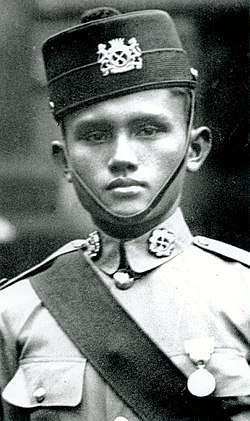Adnan Saidi
| 2nd Lieutenant Adnan bin Saidi آدنان بن سيدي SM, DM, WM, Best Recruit (RMR) | |
|---|---|
 Adnan Saidi in 1942 or earlier | |
| Born |
1915 Sungai Ramal, Kajang, Selangor Darul Ehsan, Federated Malay States, Malaya (now Malaysia) |
| Died |
14 February 1942 (aged 27) Pasir Panjang, Colony of Singapore, Straits Settlements (now Singapore) |
| Buried | Kranji War Memorial |
| Allegiance | Royal Malay Regiment |
| Years of service | 1933–1942 |
| Rank |
1933 – Corporal 1935 – Platoon Sergeant 1937 – Colour Sergeant 1941 – 2nd Lieutenant |
| Unit | 7th Platoon, C Company, 1st Battalion, 1st Malay Brigade |
| Battles/wars | Battle of Pasir Panjang |
| Awards |
Best Recruit in the Malay Regiment Star Medal Defence Medal War Medal |
| Spouse(s) | Sophia binte Pakir |
| Children |
Mokhtar bin Adnan Zainudin bin Adnan |
Adnan bin Saidi (Jawi: آدنان بن سيدي; 1915 – 14 February 1942) was a Malayan military officer of the 1st Infantry Brigade who fought the Japanese at the Battle of Pasir Panjang in Singapore during World War II. He is considered a national hero in Singapore and Malaysia for his actions during the battle. His name is also the namesake for the Malaysian Infantry Fighting Vehicle (MIFV).
Personal life
Adnan was born a Malay Muslim of Minangkabau descent in Sungai Ramal near Kajang, Selangor, Malaya. He was the eldest child in his family. His younger brothers, Ahmad and Amarullah, were also soldiers. Ahmad was killed in action after his ship, HMS Pelanduk, was sunk by the Japanese en route to Australia. Amarullah survived the war and now resides in Kajang, Selangor.
Adnan married Sophia Pakir (died 1949), an Islamic religious teacher. They had a daughter who died soon after birth, and two sons: Mokhtar, who lives in Seremban, and Zainudin, who lives in Johor. Mokhtar recalled that his father "did not talk a lot", was "a strict man and believed in discipline", and was "always serious and fierce ... yet had a good heart. There seemed to be a 'light' illuminating his face."[1]
Battle of Pasir Panjang
In 1942, Adnan led a 42-strong platoon from the Malay Regiment to defend Singapore from the invading Japanese Imperial Army. They fought at Pasir Panjang Ridge in the Bukit Chandu ("Opium Hill") area between 12 and 14 February.[2] Despite being heavily outnumbered, Adnan refused to surrender and urged his men to fight to the end. They held off the Japanese for two days amid heavy enemy shelling from artillery and tanks, as well as chronic shortages of food, medical supplies and ammunition. On the last day of the battle, Adnan and his men were left with only a few grenades and had to fight the Japanese with their bayonets in brutal hand-to-hand combat. Adnan was shot but he continued fighting.
One detail regarding the battle was how Adnan identified Japanese soldiers who were attempting to infiltrate the Malay Regiment's base in disguise as "Punjabi soldiers",[3] who were marching four abreast (Japanese style) instead of three (British style).[4]
Capture and death
Although it is widely understood that Adnan was killed during the Battle of Pasir Panjang, the exact details surrounding his death differed between accounts from both sides of the war. The actual mode of execution was never officially recorded.
The Imperial Japanese Army's official account indicated that Adnan was executed and then hung upside down from a cherry tree after two days of stubborn retaliation and refusal to surrender. (Other accounts suggest that he might have been tied to the tree and repeatedly bayoneted to death.[4][5]) British accounts confirmed that his corpse was found hung upside down after the surrender and this has been repeated in a number of authoritative texts on the Malayan Campaign.
Legacy
Adnan is considered a national hero in Singapore and Malaysia due to his courageous and valiant actions at the Battle of Pasir Panjang.[6]
War Memorial
A war memorial plaque honouring Adnan and the Malay Brigade was erected by Lee Kuan Yew, the first Prime Minister of Singapore, in 1995 at Vigilante Drive, Kent Ridge Park, Singapore.[7]
A colonial-era bungalow at Bukit Chandu was converted into Reflections at Bukit Chandu, an interpretative centre about the Battle of Pasir Panjang.[8]
The Art in Transit programme of Pasir Panjang MRT Station, titled Lieutenant Adnan, by Ho Tzu Nyen, features mock posters all around the station and lift shaft for a fictional movie about Adnan, who is portrayed by Singaporean actor Aaron Aziz.[9]
Portrayal in film
Adnan was portrayed by Malaysian actor Hairie Othman in the 1999 film Leftenan Adnan.[10] He was also portrayed by an unknown Malay actor in the 2001 Singaporean television series A War Diary. Aaron Aziz also portrayed Adnan in an episode of the 2004 historical series Life Story from Mediacorp Channel 5, which also covers his personal life.[11]
References
- ↑ "Biography – Lt. Adnan Saidi, 1915 – 1942, Infantry Officer, War Hero by Liza Sahid in 1995". Habitat News – National University Singapore. 9 September 1995. Retrieved 26 February 2017.
- ↑ The Battle of Pasir Panjang Revisited-MINDEF.gov.sg Archived 3 March 2016 at the Wayback Machine.
- ↑ "Lieutenant Adnan bin Saidi". Singapore Heroes. Retrieved 9 January 2015.
- 1 2 Lieutenant Adnan bin Saidi and The Malay Regiment Archived 12 November 2012 at the Wayback Machine.
- ↑ "bosmalay4.html". www.oocities.org.
- ↑ "Adnan bin Saidi". Badass of the Week. Backroom Productions, Inc. Retrieved 9 January 2015.
- ↑ Sahid, Liza. "Biography – Lt. Adnan Saidi". Retrieved 9 January 2015.
- ↑ https://www.nhb.gov.sg/museums/reflections-at-bukit-chandu
- ↑ https://www.lta.gov.sg/content/dam/ltaweb/corp/PublicTransport/Art%20in%20Transit/CCL%20Gallery/CC26%20Pasir%20Panjang%20(1024).jpg
- ↑ "Leftenan Adnan Saidi". Retrieved 9 January 2015.
- ↑ Life Story Archived 23 October 2007 at the Wayback Machine., Channel 5 12 September 2006. Retrieved 18 September 2007.